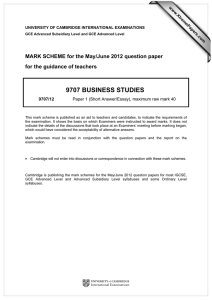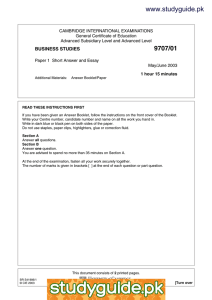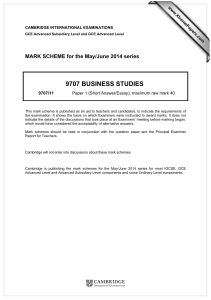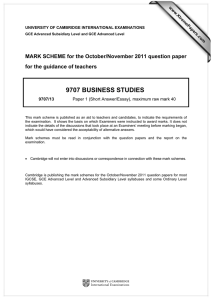9707 BUSINESS STUDIES MARK SCHEME for the October/November 2013 series
advertisement
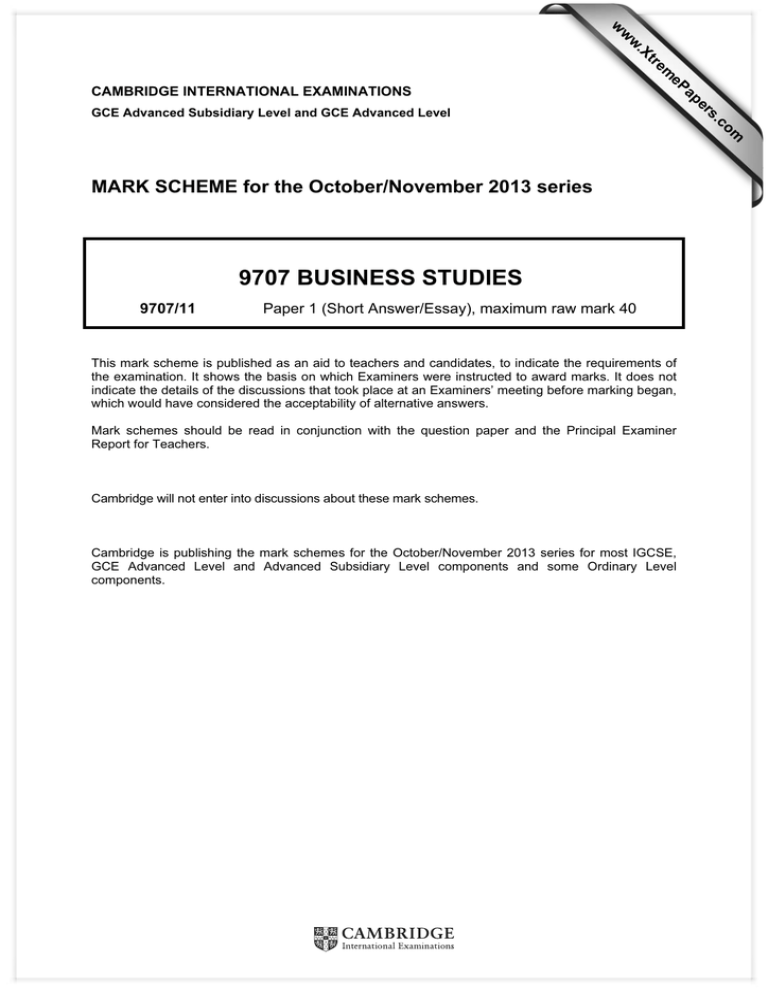
w w ap eP m e tr .X w CAMBRIDGE INTERNATIONAL EXAMINATIONS 9707 BUSINESS STUDIES 9707/11 Paper 1 (Short Answer/Essay), maximum raw mark 40 This mark scheme is published as an aid to teachers and candidates, to indicate the requirements of the examination. It shows the basis on which Examiners were instructed to award marks. It does not indicate the details of the discussions that took place at an Examiners’ meeting before marking began, which would have considered the acceptability of alternative answers. Mark schemes should be read in conjunction with the question paper and the Principal Examiner Report for Teachers. Cambridge will not enter into discussions about these mark schemes. Cambridge is publishing the mark schemes for the October/November 2013 series for most IGCSE, GCE Advanced Level and Advanced Subsidiary Level components and some Ordinary Level components. om .c MARK SCHEME for the October/November 2013 series s er GCE Advanced Subsidiary Level and GCE Advanced Level Page 2 1 Mark Scheme GCE AS/A LEVEL – October/November 2013 Syllabus 9707 Paper 11 (a) Performance related pay can be defined as a bonus scheme to reward staff for above average performance – e.g. achieving/exceeding expectations against a set standard. • Partial definition given • Full definition given [1] [2] (b) Disadvantages of PRP are often given as: – It can be difficult/costly for the company to establish the appropriate standard/system/ supervision for awarding PRP. – It can fail to motivate staff if their ‘needs’ are not primarily financial. – PRP can be divisive if there is a focus on individual performance (to the detriment of the team). – It can lead to allegations of favouritism by management. – Levels of PRP can often be inadequate. – Can lead to greater control over workers and encourage a controlling type of management. • Partial explanation of one disadvantage or a list of two. • Sound explanation of one disadvantage or partial explanation of two. • Sound explanation of two disadvantages. 2 [1] [2] [3] (a) Primary research is defined as: – the collection of first hand data – directly related to the needs of a business/customer/market/products – accurate examples of methods used to carry out primary research • Partial definition • Sound definition [1] [2] (b) Disadvantages of conducting primary research include: – – – – On its own primary research might not be sufficient for the organisation. Expensive – detailed and specific surveys are costly. It may well be time-consuming (internet secondary research much quicker). There may be doubts over accuracy and validity because of the need to use sampling – these may not be representative of the total population. – On its own primary research may not be sufficient for the organisation. • Partial explanation of one disadvantage or a list of two. • Sound explanation of one disadvantage or partial explanation of two. • Sound explanation of two disadvantages. © Cambridge International Examinations 2013 [1] [2] [3] Page 3 3 Mark Scheme GCE AS/A LEVEL – October/November 2013 Syllabus 9707 Paper 11 The rights of employees as a stakeholder group include: – To be treated within the minimum limits of protective legislation, e.g. minimum wage, health and safety. – To be treated by the employer according to employment contract. – To be allowed to join a trade union – make representations to employers. The responsibilities of employees as stakeholders include: – To meet the conditions of the employment contract. – To co-operate with management in all reasonable requests. – To observe any ethical code of conduct. • Limited reference to employees as stakeholders and/or to their rights and responsibilities or definition of stakeholders. [1] • Sound explanation of either employee rights or employee responsibilities. [2–3] • Partial explanation of employee rights and employee responsibilities. [2–3] • Sound explanation of employee rights and employee responsibilities. [4–5] 4 (a) Businesses can be described as either being ‘capital intensive’ – operations involving a high level of capital equipment compared with labour input, or ‘labour intensive’ – where operations involve a high level of labour input compared with capital equipment. • Partial distinction made or accurate definition of either capital intensive or labour intensive [1] • Sound distinction made [2] (b) A switch from labour to capital intensive production methods might be explained by: – – – – – Relative prices of the two inputs may change – labour costs significantly increase. Cost of capital machinery may reduce. Technological development may allow production process (or parts of it) to be mechanised. Competitors may force a business into capital intensive approach. Business may become large enough/profitable enough to purchase capital machinery. • • • Partial explanation of one factor or a simple list of two. Sound explanation of one factor or partial explanation of two. Sound explanation of two factors. © Cambridge International Examinations 2013 [1] [2] [3] Page 4 5 Mark Scheme GCE AS/A LEVEL – October/November 2013 Syllabus 9707 Paper 11 (a) The distinction between capital and revenue expenditure may be explained in the following terms: – – – – – – – • • • • Definitions of both: – capital expenditure – purchase of long-lasting assets; revenue expenditure – spending on costs and assets other than fixed assets. They will almost certainly be financed in different ways. In accountancy terms, they will be recorded differently All revenue expenditure will be recorded on each year’s Income Statement and will, therefore, reduce that year’s profits; – capital expenditure is recorded on the Balance Sheet as a depreciation item on each year’s Balance Sheet. Capital expenditure more likely to increase the earning capacity of a business (its noncurrent assets) while revenue expenditure merely maintains the assets earning capacity. Capital expenditure increases a business’s asset position. Improper asset classification can skew the financial position of a business. Analysis of the distinction between revenue and capital expenditure. [7–8] Good explanation of the distinction between revenue and capital expenditure. [5–6] Limited explanation of the distinction between revenue and capital expenditure. [3–4] Little understanding of the distinction between revenue and capital expenditure/ definition given. [1–2] (b) Internal sources of finance to fund capital expenditure include: – – – – Retained profits in a business can finance capital expenditure – assuming it is trading profitably. Newly-formed companies or loss trading companies limited opportunity to use/access internal sources. Sale of assets can raise cash for established companies – leasing will also raise capital (e.g. a company can sell its valuable HQ and lease it back). Reductions in working capital – can lead to liquidity concerns. Many advantages for using internal sources – no direct cost to the business – no increase in liabilities or debts, or loss of control by owners. But not available to all companies. May slow down growth as there will be a limit to amount of capital available usually. So external sources may well be required. • • • • Evaluative comment on appropriateness of using internal sources. [9–12] Analysis of appropriateness of internal financing. [7–8] Discussion of appropriateness of internal financing. [3–6] Limited discussion of appropriateness or some understanding of internal financing. [1–2] – – – – © Cambridge International Examinations 2013 Page 5 6 Mark Scheme GCE AS/A LEVEL – October/November 2013 Syllabus 9707 Paper 11 Business enterprise defined as activity where the primary motive is profit – production of goods/ services to consumers at a profit – create wealth. Social enterprise more narrowly defined – social mission-driven organisations applying marketbased strategies to achieve a social purpose/environmental purpose – re-investment of profits into community or back into business. – – – In many ways they are very different – but in some ways very similar. Business enterprise may be identified as: (entrepreneurs) – create employment – generate business activity. – increase economic growth – GDP of a country increased. – business grows and develops – multi-nationals. – innovation and technological development takes place. – international competitiveness improved – export markets. – economic development improves social cohesion. – all the benefits of a successful market enterprise system. – but can be socially responsible (and socially irresponsible) and advance social issues and cohesion. Social enterprise may include: (triple bottom line) – specific social benefit to economies (national and local). – create employment for often disadvantaged employees and communities. – protect and advance environmental issues alongside production processes. – re-distribute production benefits, not just to shareholders or a limited number of shareholders. – complement wholly public sector owned organisations. – highlight ways in which business enterprise can be improved. – in so doing create employment – generate taxation and economic benefit. Social enterprise units can be entrepreneurial and very efficient, and business enterprise units can be very socially responsible. • • • • • Evaluative comment on the differences and similarities between ‘business enterprise’ and ‘social enterprise’ for economies. [17–20] Analysis of the differences and similarities between ‘business enterprise’ and ‘social enterprise’ for economies. [13–16] Discussion of the differences and similarities between ‘business enterprise’ and ‘social enterprise’ for economies. [11–12] Some understanding of the differences and similarities between ‘business enterprise’ and ‘social enterprise’ for economies. [5–10] Very little understanding of ‘business enterprise’ and/or ‘social enterprise’. [1–4] © Cambridge International Examinations 2013 Page 6 7 Mark Scheme GCE AS/A LEVEL – October/November 2013 Syllabus 9707 Paper 11 (a) ‘Above the line promotion is: – – – – A form of paid-for communication by business in the mass media to inform and persuade – e.g. advertising on TV, cinema, newspapers. Main aim is to inform, raise awareness and build brand positioning – relatively high cost promotion. It can be targeted but often is seen by anyone outside of the target audience. Communication targeted to a wider spread of audience and not specific to individual consumers. Below the line promotion is: – – – Promotional activities where business has direct control over the target or intended audience – sales promotions – personal selling, sponsorship, PR, point of purchase promotions. Designed to achieve short-term sales increases and repeat purchases by consumers. More one-to-one approach, e.g. sampling, demonstrations – more touch and feel. Why use both: – – These two types of promotion are used in pursuit of essential marketing objectives – To maximise the present information to customers and others. To increase demand and build brand awareness. To differentiate a product and drive sales through specific promotional offers. The distinction between the two kinds of promotion is not absolute and some see the terminology as antiquated – digital communication has broken down the boundaries – now the phrase ‘Through the line’ is increasingly being used where for example a TV advert is combined with a flyer through the door – multiple consumer engagement points. • • • • Analysis of why ATL and BTL might be used. Good explanation of why ATL and BTL might be used. Limited explanation of why ATL and/or BTL might be used. Little understanding of promotion methods. [7–8] [5–6] [3–4] [1–2] (b) The discussion of advantages from effective branding could include: – – – – – – – – – A strategy that differentiates a product from competitors by creasing an identifiable image and clear expectations of the product. It can create a powerful image in the minds of customers, e.g. for quality/style. Provides a product with a unique identity. Increase the chances of brand recall by consumers. Allow for a ‘family’ of closely associated products to be established. Reduce price elasticity of demand as consumers prefer well known brands. Increases consumer loyalty to brands. Brand can give reputation and goodwill. Creating durable and distinctive perceptions in the minds of consumers is then potentially very valuable – but it can be expensive to establish and it needs careful protection and safeguarding. • • • • Evaluative comment on advantages of effective branding in context. Analysis of advantages of effective branding in context. Discussion of advantages of effective branding. Limited understanding of branding. © Cambridge International Examinations 2013 [9–12] [7–8] [3–6] [1–2]


